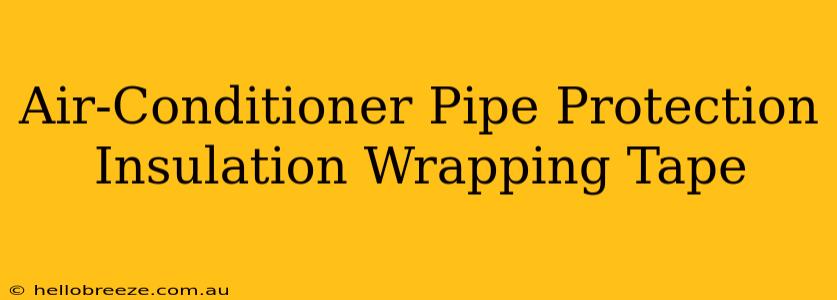Protecting your air conditioner's pipes is crucial for efficient operation and longevity. Heat loss in the summer and heat gain in the winter significantly impact your system's performance, leading to higher energy bills and potential equipment failure. This guide delves into the importance of pipe insulation, focusing on the effective use of insulation wrapping tape, and explores other protective measures to safeguard your AC system.
Why Insulate Your AC Pipes?
Ignoring pipe insulation can lead to several problems:
-
Increased Energy Costs: Uninsulated pipes lose significant amounts of cooled or heated air, forcing your AC unit to work harder and consume more energy to maintain the desired temperature. This translates directly into higher electricity bills.
-
Reduced Efficiency: Heat transfer through uninsulated pipes decreases the efficiency of your air conditioning system. Your system won't cool your home as effectively, resulting in discomfort and potential equipment strain.
-
Condensation and Leaks: Temperature fluctuations on uninsulated pipes can cause condensation, potentially leading to water damage and even leaks. This is particularly problematic in areas with high humidity.
-
Frozen Pipes (in winter): In colder climates, uninsulated pipes carrying refrigerant can freeze, causing serious damage to your system and requiring costly repairs.
The Benefits of Insulation Wrapping Tape
Insulation wrapping tape offers a cost-effective and easy-to-apply solution for protecting your air conditioner's pipes. This flexible material comes in various thicknesses and materials, offering excellent thermal protection. Here's why it's a popular choice:
-
Ease of Installation: Wrapping tape is simple to apply, even for DIY enthusiasts. No special tools or skills are typically required.
-
Cost-Effectiveness: Compared to other insulation methods, wrapping tape is generally more affordable, making it an attractive option for budget-conscious homeowners.
-
Flexibility and Adaptability: The flexible nature of the tape allows it to conform to various pipe sizes and shapes, ensuring a snug and effective seal.
-
Variety of Materials: Wrapping tapes are available in different materials, including foam, rubber, and fiberglass, each offering varying levels of insulation and durability. Choose the material best suited to your climate and application.
Choosing the Right Insulation Wrapping Tape
Consider these factors when selecting your insulation wrapping tape:
-
R-Value: The R-value indicates the material's resistance to heat flow. Higher R-values signify better insulation.
-
Thickness: Thicker tape generally provides superior insulation but may be more challenging to apply.
-
Material: Different materials offer varying benefits; research the best option for your specific needs and climate.
-
Pipe Diameter: Ensure you purchase enough tape to adequately cover your pipes.
Beyond Insulation Wrapping Tape: Other Protective Measures
While insulation wrapping tape is an effective solution, it's not the only way to protect your AC pipes. Consider these additional measures:
-
Pipe Insulation Sleeves: These pre-formed sleeves offer a quicker installation compared to wrapping tape but can be less flexible and more expensive.
-
Proper Pipe Placement: Avoid placing pipes in direct sunlight or areas exposed to extreme temperatures.
-
Regular Maintenance: Regularly inspect your pipes for signs of damage or deterioration. Address any issues promptly to prevent larger problems down the line.
Conclusion: Protecting Your Investment
Protecting your air conditioner's pipes through insulation and other preventative measures is essential for maintaining efficiency, extending the lifespan of your system, and ultimately saving you money on energy costs. Investing in quality insulation wrapping tape or other appropriate insulation methods is a smart investment that pays dividends in the long run. By taking these steps, you ensure your AC system operates at peak performance, keeping you comfortable and saving you money year after year.

